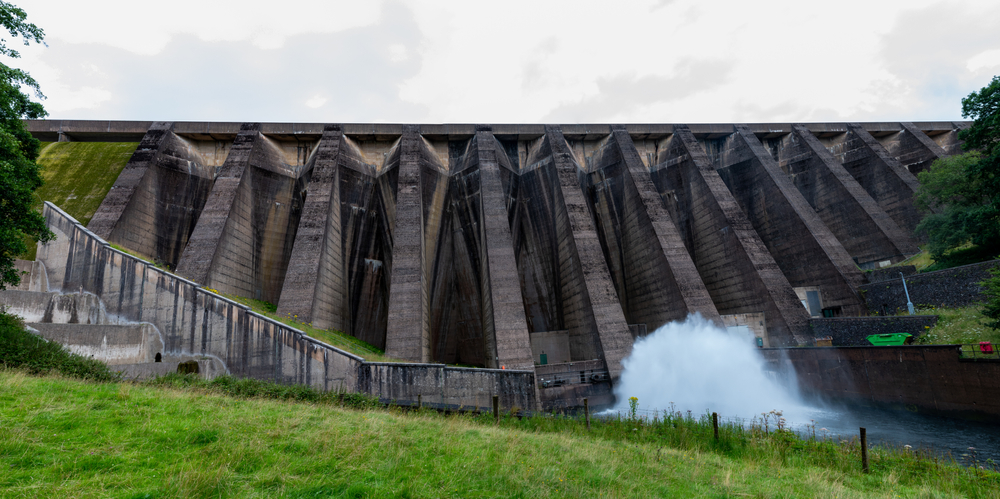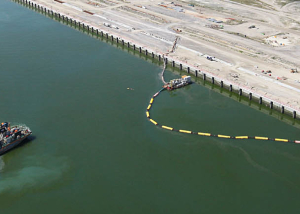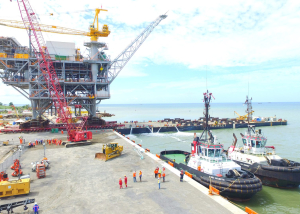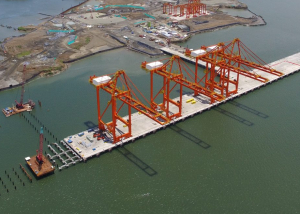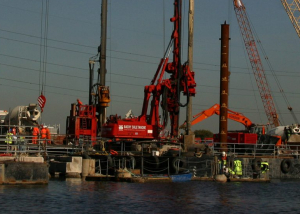THE SCHEME
Wimbleball Dam is a 50m high concrete buttress dam constructed across the River Haddeo, a headwater of the River Exe in Somerset. The reservoir is a strategic water resource for both South West Water & Wessex Water. Since construction in 1978, increased leakage has occurred beneath the dam. In 2010 a reservoir inspecting engineer considered the leakage to be untenable and recommended that measures be put in place to reduce the leakage.
Bachy Soletanche was contracted to:
- Repair and extend the existing grout curtain below the south flank, dam crest and south abutments of Wimbleball Dam, thereby reducing the leakage to sustainable levels, and by so doing minimise the loss of fines from beneath the dam.
- Install a novel and complex water treatment system to capture and treat all discharge
The project was particularly challenging as the reservoir could not be emptied during the works and the grouting had to seal flowing features in very high permeability rock.
CONSTRUCTION
Using drilling and grouting Bachy Soletanche:
- Determined the required quantities of grout using investigative techniques and analysis
- Injected the grout with state of the art grouting control procedures.
To achieve a durable grout curtain:
- A low target permeability grout was formulated, tested and underwent site trials.
- Blast furnace slag was used to resist the aggressive reservoir water.
- Grout mixes included micro and ultrafine fine cements and silica fume.
The principles of the Grouting Intensity Number (GIN) method were adopted to control the grout injections. The GIN method uses:
- Stable grouts and constant injection rates,
- real time monitoring of flow, volume and pressures
- termination based on a curve reflecting energy expended.
This project successfully grouted the fissures by employing:
- The GIN grouting method, using state of the art computer-controlled grout injections
- an observational design approach using geophysics, televiewer logging and high quality hydrotesting as well as grouting trials and continual review of the grout injections
- continual review of injections as work progressed
- real-time monitoring of the pore-water pressures and dam movements to ensure safety.
Validation testing demonstrated that the mean permeability of the new curtain reduced to approximately 3×10-8m/s, ensuring the longevity of the curtain. As Principal Contractor, Bachy Soletanche were also responsible for the management of the project from site set up to completion of the reinstatement.
The designers of the works, CH2MHILL, were responsible for detailing the employer’s requirements, including modelling the dam and the grout curtain solution. BSL, CH2MHILL and the client worked closely together throughout the ECI phase in order to develop a realistic construction programme and to refine the optimum design solution. These deliberations included the rationalisation of the GIN (GIN = Grout Intensity Number), procedures selected to ensure that the specification requirements would be achieved. Working in this collaborative manner allowed the teams to modify the grout mixes and injection parameters as the works progressed, resulting in the success of the project.
Bachy Soletanche employed an innovative approach to model the advance of cracks along the foundation contact. 3D modelling of the complex dam geometry and borehole alignment was developed to target the boreholes upstream of the dam foundation and existing, ineffective, grout curtain. Prior to commencing the main works, a series of full scale grout trials were undertaken on site in order to validate the proposed drilling and grouting techniques. These trial works comprised the drilling of Inspection Holes, followed by the drilling and grouting of Primary, Secondary & Tertiary holes for grout injection and design validation.
Drilling and grouting operations were executed from three locations. Two between the dam buttresses at a level of 25m below the reservoir head, requiring holes to be drilled through blow out preventers, and the third location was on the crest road 5-6m above reservoir water level. Once the drill rig had been set up in the correct position a hole was drilled through the concrete buttress and dam foundation (average depth 25m), to the base of grout stage 1 in the rock.
Grouting was carried out by traditional descending stage methods, commencing at the dam foundation level and progressing stage by stage to full depth of the borehole, with typical stage lengths of 3-5m, and with 6-8 stages per borehole. Within each drilled stage a modified, stable, cement-bentonite grout, of low water cement ratio, but high penetrability was injected. Injection grouting was carried out using a computer controlled electro-hydraulic grouting unit, the grouting instructions for each injection stage of each borehole being downloaded daily from the site.
Post grouting validation holes were drilled and tested for approval. Bachy Soletanche were also required to install a series of Pressure Relief wells, comprising a 75mm diameter slotted pipe (10% slots), encased in granular stone and terminating at ground level within a secure box.
The project was highly successful, with leakage reduced to the lowest levels since construction of the dam.
